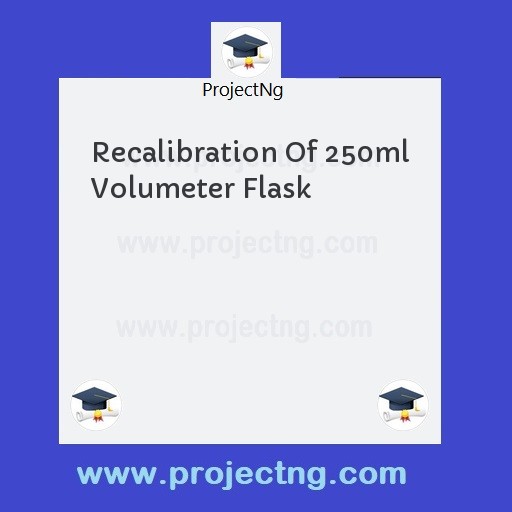Recalibration Of 250ml Volumeter Flask
Science Lab Technology Project Topics
Get the Complete Project Materials Now! »
RECALIBRATION OF 250ML VOLUMETER FLASK
ABSTRACT
Recalibration of 250ml volumetric flask from time to time is very vital for determination of its accuracy and precision compared with its original manufacturers calibration. It gives a sound understanding of modern measurement methods and knowledge of equipment used. Glass is known to play an important role in the modern technology as it is used in the production of laboratory apparatus, e.g. volumetric flask, measuring cylinder etc. from this project work, it was shown in chapter three and four that recalibration is all about quantitative measurement and the process of checking a measuring system of equipment readings against a higher reference standard. The results in chapter four were checked against the tolerance of class a volumetric flask in table one.
It was also shown that expansion and contraction, which is due to temperature changes, has taken place in the internal component of the flask.
TABLE OF CONTENTS
Title Page
Dedication
Acknowledgement
Certification
Abstract
Table of Contents
CHAPTER ONE
1.0 Introduction
1.1 Background information and definition
1.2 Statement of problem
1.3 Aims and objective of the study
1.4 Hypothesis
1.5 Limitation
1.6 Significance of the study
CHAPTE TWO
2.0 Literature review
2.1 Explanation of recalibration
2.2 Calibration of volumetric flask
2.3 Uses of volumetric flask
2.4 Glass
2.5 Advantages of glass
2.6 Disadvantages of glass
2.7 Source of error
CHAPTER THREE
3.0 Materials and method
3.1 Material
3.2 Experimental procedure
CHAPTER FOUR
4.0 Result
4.1 Precaution taken
CHAPTER FIVE
5.0 Conclusion and Recommendation
5.1 Conclusion
5.2 Recommendation
REFERENCES
CHAPTER ONE
1.0 INTRODUCTION
1.1 BACKGROUND INFORMATION AND DEFINTION
In the laboratory, many apparatus are being used these equipments are normally calibrated at a standard temperature recommended by the national standard of weights of the particular country of the manufacturer. In America, national bureau of standard institution (NBSI) is been used. For every accurate work, it may be necessary to recalibrate a particular piece of apparatus in the laboratory. For this purpose, it is desirable to recalibrate a (250ml) volumetric flask, to measure the exact volumes delivered or contained (MCGRAW Hill 1971).
Calibration is defined as a quantitative measurement of the instrument undertaken to ensure accurate performance confirmation. It generally involves adjusting the values of internal components so that the indication is correct at a specific number of points on the indicating scale and approximately correct between these points.
Volumetric flask is glassware that points in the laboratory for analytical experiment. It is used to prepare a solution of a known volume. It is calibrated to contain a particular volume of water (distilled water) at 20oC, when the bottom of the meniscus is adjusted to the center of the line marked of the neck of the flask. Most flack bears the label TC 20oC, which means that the flask is calibrated to contain the indicated volume at 20oC temperature range.
1.2 STATEMENT OF PROBLEM
Many laboratory instruments exhibit drift, a show charge in output. Environmental factor such as temperature also affects the performance of certain instruments in the laboratory. The instrument maker must choose materials and operating principles, which will minimize this effect and the user must develop measurement techniques (e.g. recalibration) which either avoid these effects or correct for them.
1.3 AIMS AND OBJECTIVE OF THE STUDY
AIM
To recalibrate 250ml volumetric flask that can be used to prepare a solution of known volume.
OBJECTIVES
i. To give a sound understanding of modern measurement methods and knowledge of equipment used.
ii. To experiment, promote and improve techniques in handling of volumetric flak.
1.4 HYPOTHESIS
i. In regard to the accuracy of an instrument, it should be noted that no instrument is accurate in an absolute sense.
ii. Every instrument (devices) gives only a more or less close approximation to the standard value.
iii. Recalibration is carried out for reliability and accurate scientific work.
Be the First to Share On Social

Enjoying our content?
Don't miss out on new videos! Subscribe to our YouTube channel for more awesome content.
Subscribe Now!













